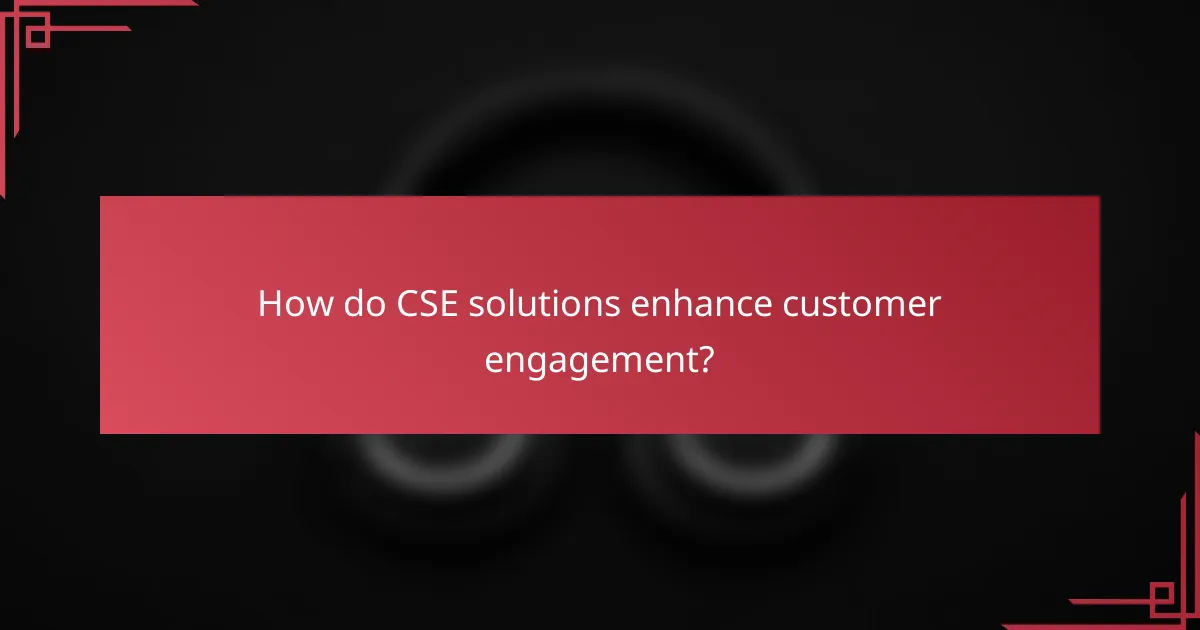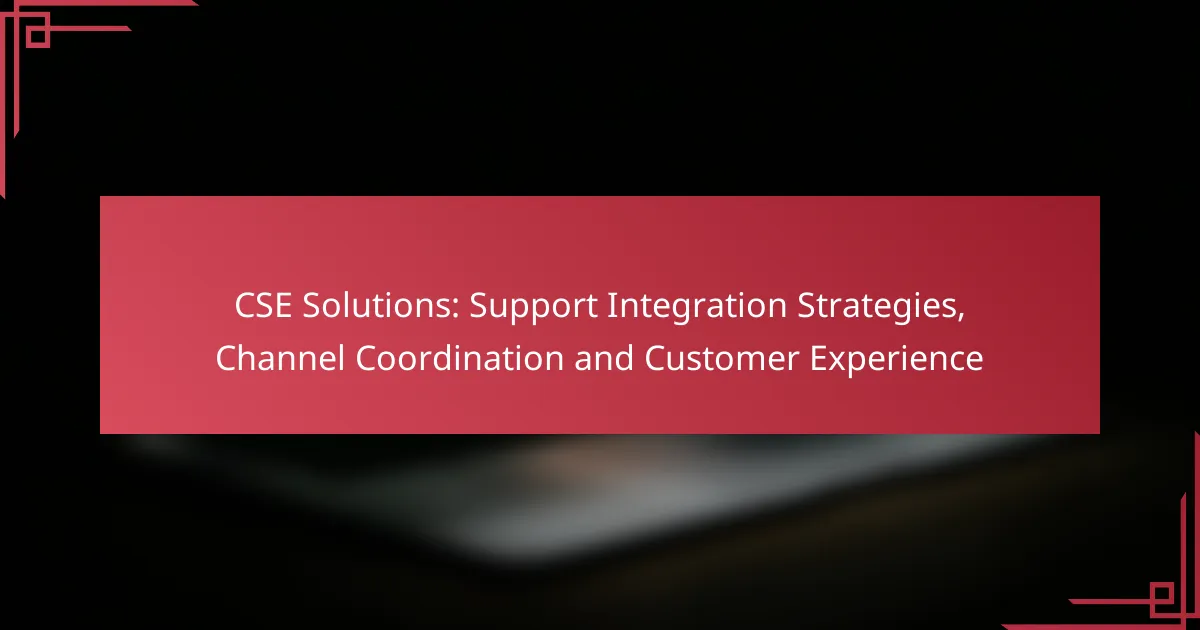CSE solutions play a crucial role in enhancing customer engagement and satisfaction through effective omnichannel support. By integrating live chat, social media, email, and self-service portals, businesses can ensure seamless communication across various platforms. This personalized approach not only meets customer needs but also fosters loyalty and satisfaction through timely and tailored interactions.

What are the key omnichannel support solutions in the UK?
Key omnichannel support solutions in the UK include live chat, social media engagement, email support systems, phone support integration, and self-service portals. These solutions enhance customer engagement and satisfaction by providing seamless communication across various platforms.
Live chat support
Live chat support allows customers to interact with representatives in real-time through a website or app. This solution is effective for addressing inquiries quickly, often resulting in higher satisfaction rates. Businesses should consider implementing chatbots for initial queries to reduce wait times and enhance efficiency.
When choosing a live chat solution, look for features like chat history, automated responses, and integration with CRM systems. These features help streamline communication and provide a better customer experience.
Social media engagement
Social media engagement involves interacting with customers on platforms like Facebook, Twitter, and Instagram. This method is crucial for building brand loyalty and addressing customer concerns in a public forum. Companies should actively monitor their social media channels to respond promptly to comments and messages.
Effective social media engagement strategies include creating engaging content, running targeted ads, and using analytics tools to track performance. Regularly engaging with customers can significantly enhance brand perception and customer satisfaction.
Email support systems
Email support systems provide a structured way for customers to submit inquiries and receive responses. This solution is beneficial for handling complex issues that require detailed explanations. Businesses should aim to respond to emails within a reasonable timeframe, ideally within 24 hours.
To optimize email support, consider using templates for common inquiries and implementing a ticketing system to track requests. This can help ensure that no customer query goes unanswered and improves overall efficiency.
Phone support integration
Phone support integration allows customers to reach support teams via telephone, providing a personal touch that many customers appreciate. This method is particularly effective for urgent issues that require immediate attention. Companies should ensure that phone support is easily accessible and that wait times are minimized.
Utilizing call routing systems can help direct customers to the appropriate department quickly. Additionally, offering callback options can enhance customer satisfaction by reducing the time spent on hold.
Self-service portals
Self-service portals empower customers to find solutions independently, reducing the need for direct support. These portals typically include FAQs, troubleshooting guides, and instructional videos. By providing comprehensive self-service options, businesses can enhance customer satisfaction and reduce support costs.
When developing a self-service portal, ensure that it is user-friendly and regularly updated with relevant information. Incorporating search functionality and categorizing content can help customers find answers more efficiently.

How do CSE solutions enhance customer engagement?
CSE solutions significantly enhance customer engagement by providing personalized interactions, leveraging data insights, and facilitating proactive communication. These strategies create a more tailored experience for customers, leading to increased satisfaction and loyalty.
Personalized communication strategies
Personalized communication strategies involve tailoring messages and interactions based on individual customer preferences and behaviors. This can include using a customer’s name, recommending products based on past purchases, or sending targeted promotions that align with their interests.
To implement personalized strategies effectively, businesses can utilize customer relationship management (CRM) systems that track customer interactions and preferences. This allows for segmentation and targeted messaging, which can improve response rates and overall engagement.
Data-driven customer insights
Data-driven customer insights are critical for understanding customer needs and behaviors. By analyzing data from various touchpoints, such as website visits, purchase history, and customer feedback, businesses can identify trends and preferences that inform their engagement strategies.
Utilizing analytics tools can help companies gather and interpret this data, enabling them to make informed decisions. For instance, businesses might discover that a significant portion of their customers prefers communication via social media, prompting a shift in their engagement approach.
Proactive outreach initiatives
Proactive outreach initiatives involve anticipating customer needs and reaching out before issues arise. This can include sending reminders for upcoming appointments, follow-ups after purchases, or alerts about potential service disruptions.
To be effective, companies should establish a system for monitoring customer interactions and feedback. Regularly checking in with customers can help identify potential issues early, allowing businesses to address concerns before they escalate, ultimately enhancing customer satisfaction.

What is the impact of CSE solutions on customer satisfaction?
CSE solutions significantly enhance customer satisfaction by streamlining communication and support processes. By providing timely assistance and personalized interactions, businesses can effectively meet customer needs and expectations.
Improved response times
One of the primary benefits of CSE solutions is the reduction in response times. With automated systems and omnichannel support, customers can receive answers to their inquiries within minutes, rather than hours or days. This swift service not only resolves issues quickly but also demonstrates a company’s commitment to customer care.
To achieve improved response times, businesses should implement chatbots for common queries and ensure that support teams are well-trained in using CSE tools. Regularly monitoring response metrics can help identify areas for further enhancement.
Higher customer retention rates
CSE solutions contribute to higher customer retention rates by fostering a positive experience throughout the customer journey. When customers feel valued and supported, they are more likely to continue doing business with a company. Studies indicate that companies with effective customer support can see retention rates increase by significant margins.
To maximize retention, organizations should focus on personalized follow-ups and proactive communication. Utilizing customer feedback to improve service offerings can also help maintain loyalty and encourage repeat business.
Increased customer loyalty
Implementing CSE solutions can lead to increased customer loyalty, as satisfied customers are more inclined to recommend a brand to others. A seamless and enjoyable customer experience builds trust and encourages long-term relationships. Companies that prioritize customer engagement often see loyalty metrics rise substantially.
To cultivate loyalty, businesses should create loyalty programs that reward repeat customers and actively engage with them through various channels. Regularly soliciting feedback and making adjustments based on customer input can further solidify their commitment to the brand.

What criteria should businesses consider when choosing CSE solutions?
Businesses should consider factors such as scalability, integration capabilities, and cost-effectiveness when selecting Customer Service Experience (CSE) solutions. These criteria ensure that the chosen platform can grow with the business, work seamlessly with existing systems, and provide value for money.
Scalability of the platform
Scalability refers to a platform’s ability to handle increased workloads as a business grows. When evaluating CSE solutions, look for options that can accommodate a rising number of users and interactions without compromising performance. A scalable solution can adapt to seasonal spikes in customer engagement or expansion into new markets.
Consider solutions that offer flexible pricing models, such as pay-per-use or tiered subscription plans, which allow businesses to scale their usage according to demand. This flexibility can prevent unnecessary costs during slower periods while ensuring resources are available during peak times.
Integration capabilities with existing systems
Integration capabilities are crucial for ensuring that a CSE solution works well with a business’s current tools and systems. Look for platforms that support APIs and have pre-built connectors for popular software like CRM systems, e-commerce platforms, and communication tools. This compatibility helps streamline processes and improves data flow across departments.
Assess the ease of integration by reviewing documentation and support resources. A solution that requires minimal technical expertise to integrate can save time and reduce the risk of implementation issues. Additionally, consider the potential for future integrations as your technology stack evolves.
Cost-effectiveness of solutions
Cost-effectiveness involves evaluating the total cost of ownership against the benefits provided by the CSE solution. Businesses should analyze not only the initial purchase price but also ongoing costs such as maintenance, training, and support. A solution that appears inexpensive upfront may incur hidden costs that affect overall value.
To determine cost-effectiveness, compare features and pricing across multiple vendors. Look for solutions that offer a strong return on investment through improved customer satisfaction and engagement. Additionally, consider the potential for increased sales and reduced churn as indicators of long-term value.

What are the best practices for implementing omnichannel support?
Implementing omnichannel support effectively requires a strategic approach that integrates various communication channels to enhance customer engagement and satisfaction. Key practices include training staff on new tools, regularly updating customer feedback mechanisms, and monitoring performance metrics to ensure a seamless experience across all platforms.
Training staff on new tools
Training staff on new tools is essential for successful omnichannel support. Employees should be well-versed in using various platforms, such as chat systems, CRM software, and social media channels, to provide consistent service. Regular training sessions can help staff stay updated on the latest features and best practices.
Consider using role-playing scenarios to simulate customer interactions across different channels. This hands-on approach can improve staff confidence and adaptability when addressing customer inquiries.
Regularly updating customer feedback mechanisms
Regularly updating customer feedback mechanisms is crucial for understanding customer needs and preferences in an omnichannel environment. Utilize surveys, feedback forms, and social media polls to gather insights on customer experiences across all touchpoints. This information can guide improvements in service delivery.
Implement a system for analyzing feedback trends over time. Look for patterns that indicate areas for enhancement, and be prepared to adjust strategies based on customer input to foster loyalty and satisfaction.
Monitoring performance metrics
Monitoring performance metrics helps assess the effectiveness of your omnichannel support strategy. Key metrics to track include response times, customer satisfaction scores, and resolution rates across different channels. This data can reveal strengths and weaknesses in your service approach.
Establish benchmarks for these metrics to measure progress over time. Regularly review this data to identify trends and make informed decisions about resource allocation and training needs. Aim for continuous improvement to enhance overall customer engagement.

What emerging trends are shaping omnichannel support in the UK?
Emerging trends in omnichannel support in the UK focus on enhancing customer engagement through seamless integration across various communication channels. Businesses are increasingly leveraging technology to provide personalized experiences, ensuring that customer satisfaction remains a top priority.
AI-driven customer interactions
AI-driven customer interactions are transforming how businesses engage with their customers across multiple channels. By utilizing chatbots and virtual assistants, companies can provide instant responses to inquiries, improving response times and overall customer experience.
These AI tools can analyze customer data to offer personalized recommendations, making interactions more relevant and efficient. For example, a retail company might use AI to suggest products based on a customer’s previous purchases, enhancing the shopping experience.
However, it’s crucial to balance automation with human touch. While AI can handle routine queries, complex issues should still be directed to human agents to ensure comprehensive support and maintain customer trust.


